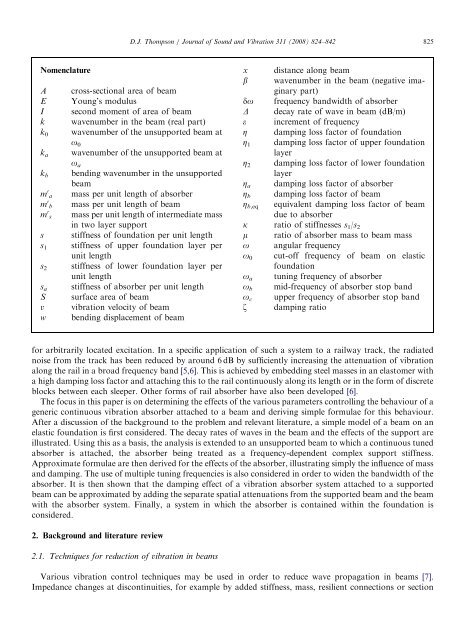A continuous damped vibration absorber to reduce broad-band ...
A continuous damped vibration absorber to reduce broad-band ...
A continuous damped vibration absorber to reduce broad-band ...
Create successful ePaper yourself
Turn your PDF publications into a flip-book with our unique Google optimized e-Paper software.
Nomenclature<br />
A cross-sectional area of beam<br />
E Young’s modulus<br />
I second moment of area of beam<br />
k wavenumber in the beam (real part)<br />
wavenumber of the unsupported beam at<br />
k0<br />
k a<br />
o 0<br />
wavenumber of the unsupported beam at<br />
o a<br />
kb bending wavenumber in the unsupported<br />
beam<br />
m0 a mass per unit length of <strong>absorber</strong><br />
m0 b mass per unit length of beam<br />
m0 s mass per unit length of intermediate mass<br />
in two layer support<br />
s stiffness of foundation per unit length<br />
s1 stiffness of upper foundation layer per<br />
unit length<br />
s2 stiffness of lower foundation layer per<br />
unit length<br />
sa stiffness of <strong>absorber</strong> per unit length<br />
S surface area of beam<br />
v <strong>vibration</strong> velocity of beam<br />
w bending displacement of beam<br />
for arbitrarily located excitation. In a specific application of such a system <strong>to</strong> a railway track, the radiated<br />
noise from the track has been <strong>reduce</strong>d by around 6 dB by sufficiently increasing the attenuation of <strong>vibration</strong><br />
along the rail in a <strong>broad</strong> frequency <strong>band</strong> [5,6]. This is achieved by embedding steel masses in an elas<strong>to</strong>mer with<br />
a high damping loss fac<strong>to</strong>r and attaching this <strong>to</strong> the rail <strong>continuous</strong>ly along its length or in the form of discrete<br />
blocks between each sleeper. Other forms of rail <strong>absorber</strong> have also been developed [6].<br />
The focus in this paper is on determining the effects of the various parameters controlling the behaviour of a<br />
generic <strong>continuous</strong> <strong>vibration</strong> <strong>absorber</strong> attached <strong>to</strong> a beam and deriving simple formulae for this behaviour.<br />
After a discussion of the background <strong>to</strong> the problem and relevant literature, a simple model of a beam on an<br />
elastic foundation is first considered. The decay rates of waves in the beam and the effects of the support are<br />
illustrated. Using this as a basis, the analysis is extended <strong>to</strong> an unsupported beam <strong>to</strong> which a <strong>continuous</strong> tuned<br />
<strong>absorber</strong> is attached, the <strong>absorber</strong> being treated as a frequency-dependent complex support stiffness.<br />
Approximate formulae are then derived for the effects of the <strong>absorber</strong>, illustrating simply the influence of mass<br />
and damping. The use of multiple tuning frequencies is also considered in order <strong>to</strong> widen the <strong>band</strong>width of the<br />
<strong>absorber</strong>. It is then shown that the damping effect of a <strong>vibration</strong> <strong>absorber</strong> system attached <strong>to</strong> a supported<br />
beam can be approximated by adding the separate spatial attenuations from the supported beam and the beam<br />
with the <strong>absorber</strong> system. Finally, a system in which the <strong>absorber</strong> is contained within the foundation is<br />
considered.<br />
2. Background and literature review<br />
2.1. Techniques for reduction of <strong>vibration</strong> in beams<br />
ARTICLE IN PRESS<br />
D.J. Thompson / Journal of Sound and Vibration 311 (2008) 824–842 825<br />
x distance along beam<br />
b wavenumber in the beam (negative imaginary<br />
part)<br />
do frequency <strong>band</strong>width of <strong>absorber</strong><br />
D decay rate of wave in beam (dB/m)<br />
e increment of frequency<br />
Z damping loss fac<strong>to</strong>r of foundation<br />
Z1 damping loss fac<strong>to</strong>r of upper foundation<br />
layer<br />
Z2 damping loss fac<strong>to</strong>r of lower foundation<br />
layer<br />
damping loss fac<strong>to</strong>r of <strong>absorber</strong><br />
Various <strong>vibration</strong> control techniques may be used in order <strong>to</strong> <strong>reduce</strong> wave propagation in beams [7].<br />
Impedance changes at discontinuities, for example by added stiffness, mass, resilient connections or section<br />
Za<br />
Zb<br />
Zb,eq<br />
damping loss fac<strong>to</strong>r of beam<br />
equivalent damping loss fac<strong>to</strong>r of beam<br />
due <strong>to</strong> <strong>absorber</strong><br />
k ratio of stiffnesses s1/s2 m ratio of <strong>absorber</strong> mass <strong>to</strong> beam mass<br />
o angular frequency<br />
o0 cut-off frequency of beam on elastic<br />
foundation<br />
oa tuning frequency of <strong>absorber</strong><br />
ob mid-frequency of <strong>absorber</strong> s<strong>to</strong>p <strong>band</strong><br />
oc upper frequency of <strong>absorber</strong> s<strong>to</strong>p <strong>band</strong><br />
z damping ratio
















